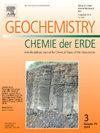阿尔及利亚东北部Kef Hahouner地区超古典纪岩石及伴生shoshonite的地质、矿物学、地球化学及Sr-Nd-Pb同位素组成:新资料及其地球动力学意义
IF 2.9
3区 地球科学
Q2 GEOCHEMISTRY & GEOPHYSICS
引用次数: 0
摘要
在阿尔卑斯-地中海地区,除了北非的Maghrebide链外,超多叠统岩石与shoshonites的结合是常见的,在那里只有两个小的超多叠统岩石露头被记录。本文报道了阿尔及利亚东北部Kef Hahouner地区火山超古生代岩石学、矿物化学、全岩地球化学和Sr-Nd-Pb同位素组成的详细野外观测和新资料。结果表明,这些岩石是由位于熔岩流层序底部的超古生代岩石和构成浅层火山侵入体和上述熔岩流堆上部的闪玄岩组合而成。超经典岩石富K2O, K2O/Na2O >;2、高Mg #(毫克/ (Mg的铁+ +)= 0.70 - -0.72),和高镍(∼173μg。g−1 [ppm])和Cr含量(~ 392 μg.g−1)。高场强元素(Ta、Nb、Ti)极富Th、LILE (Rb、Ba、Sr),表现为造山型模式。与超古典纪相相比,Shoshonites的K2O含量较低,Na2O和Al2O3含量较高。然而,这些岩石的微量元素和稀土元素(REE)模式与超古典纪岩石相似,但LILE和MREE含量略低。87Sr/86Sr的初始值为0.706101 ~ 0.709500,143Nd/144Nd的初始值为0.512246 ~ 0.512438,铅同位素比值为206Pb/204Pb的18.538 ~ 18.571,207Pb/204Pb的15.649 ~ 15.657,208Pb/204Pb的39.806 ~ 39.998。超古生代岩石87Sr/86Sr、206Pb/204Pb、208Pb/204Pb高于肖顺岩体,143Nd/144Nd低于肖顺岩体。这两个火山套很可能是由于交代地幔源部分熔融的增加,其中环境地幔成分稀释了由底脉部分熔融产生的富碱成分,解释了从超古生代到舒顺质岩浆的转变。与北非新生代岩浆带相比,Kef Hahouner的超古生代和玄武岩岩性具有独特性,在整个岩浆带中没有可比性。因此,我们提出了一种地球动力学模型,即在托尔顿时期,非洲大陆边缘在卡比利亚域下的俯冲和断裂引起了源区强烈的交代事件,导致了该地区超古典纪岩石和索顺岩体的形成和侵位。观测到的Kef Hahouner-Djebel Debar断裂可能代表了与非洲俯冲岩石圈板块南缘有关的撕裂断裂的表面表现。本文章由计算机程序翻译,如有差异,请以英文原文为准。
Geology, mineralogy, geochemistry and Sr-Nd-Pb isotopic composition of the ultrapotassic rocks and associated shoshonites of Kef Hahouner (Northeastern Algeria): New data and geodynamic implications
The association of ultrapotassic rocks and shoshonites is common in the Alpine-Mediterranean region, with the exception of the Maghrebide Chain of Northern Africa, where only two small outcrops of ultrapotassic rocks have been documented. This study reports detailed field observations and new data on the petrology, mineral chemistry, whole-rock geochemistry and Sr-Nd-Pb isotopic compositions of the volcanic ultrapotassic rocks and shoshonites of the Kef Hahouner region (Northeastern Algeria). The results indicate that these rocks are composed of an association of ultrapotassic rocks that outcrop at the base of a lava flow sequence, and shoshonites that constitute shallow volcanic intrusions and the upper part of the abovementioned lava flow pile. The ultrapotassic rocks are K2O-rich, with K2O/Na2O > 2, high Mg# (Mg/(Mg + Fe2+) = 0.70–0.72), and high Ni (∼173 μg.g−1 [ppm]) and Cr contents (∼392 μg.g−1). They are strongly enriched in LREE and extremely enriched in Th and LILE (Rb, Ba, Sr), with respect to High Field Strenght Elements (Ta, Nb, and Ti), showing an orogenic-type pattern. Shoshonites display lower K2O and higher Na2O and Al2O3 contents compared to the ultrapotassic facies. However, these rocks have similar trace and rare earth element (REE) patterns to those observed in the ultrapotassic rocks, albeit with slightly lower LILE and MREE contents. The initial 87Sr/86Sr values range from 0.706101 to 0.709500, and 143Nd/144Nd from 0.512246 to 0.512438, while the lead isotope ratios vary between 18.538 and 18.571 for 206Pb/204Pb, 15.649 to 15.657 for 207Pb/204Pb, and 39.806 to 39.998 for 208Pb/204Pb. Ultrapotassic rocks exhibit higher 87Sr/86Sr, 206Pb/204Pb, 208Pb/204Pb and lower 143Nd/144Nd than shoshonites. The two volcanic suites most likely result from the increasing partial melting of the metasomatised mantle source in which the ambient mantle component dilutes the alkaline-rich component derived from the partial melting of the sole vein, explaining the transition from ultrapotassic to shoshonite magma. Compared to the North-African Cenozoic magmatic belt, the Kef Hahouner ultrapotassic and shoshonitic lithologies are unique and have no equivalent among the entire belt. We, therefore, propose a geodynamic model in which the subduction of the African continental margin beneath the Kabylian domain and its break-off during the Tortonian times caused the strong metasomatic episode in the source region, resulting in the formation and emplacement of the ultrapotassic rocks and shoshonites in the region. The observed Kef Hahouner–Djebel Debar fault may represent the surface expression of the tear fault related to the southern edge of the African subducted lithospheric slab.
求助全文
通过发布文献求助,成功后即可免费获取论文全文。
去求助
来源期刊

Chemie Der Erde-Geochemistry
地学-地球化学与地球物理
CiteScore
7.10
自引率
0.00%
发文量
40
审稿时长
3.0 months
期刊介绍:
GEOCHEMISTRY was founded as Chemie der Erde 1914 in Jena, and, hence, is one of the oldest journals for geochemistry-related topics.
GEOCHEMISTRY (formerly Chemie der Erde / Geochemistry) publishes original research papers, short communications, reviews of selected topics, and high-class invited review articles addressed at broad geosciences audience. Publications dealing with interdisciplinary questions are particularly welcome. Young scientists are especially encouraged to submit their work. Contributions will be published exclusively in English. The journal, through very personalized consultation and its worldwide distribution, offers entry into the world of international scientific communication, and promotes interdisciplinary discussion on chemical problems in a broad spectrum of geosciences.
The following topics are covered by the expertise of the members of the editorial board (see below):
-cosmochemistry, meteoritics-
igneous, metamorphic, and sedimentary petrology-
volcanology-
low & high temperature geochemistry-
experimental - theoretical - field related studies-
mineralogy - crystallography-
environmental geosciences-
archaeometry
 求助内容:
求助内容: 应助结果提醒方式:
应助结果提醒方式:


